 Get In Touch
Get In Touch
 Get In Touch
Get In Touch
If you’re reading this, you have probably started the process of vetting web design companies. A good website is crucial to represent your brand and engage with customers. But websites can be expensive and time consuming to create. It’s understandable to be hesitant in making changes. So how do you know when to update? Here are five signs from a professional web design company that your business is ready for a new website.
Time needed: 3 minutes
As part of your integrated strategy, your website represents your brand. Customers and potential customers should be able to get an idea of who you are through the appearance and content of your site. If the look and feel doesn’t match up with your brand story, it may be time to make a change. Especially if you’ve recently rebranded, you’ll want to revamp your website to match this update.
A well-designed interface is important for your business. If customers cannot navigate easily, they will have a negative impression of your company. In addition, they will not use your services if they cannot get the information they need. Do you have a clear call to action and organized hierarchy? Users should be able to quickly see what you do and find what they’re looking for.
Responsiveness is a key aspect of a user friendly website. In a world where more and more people are using phones to go online, your website needs to be mobile friendly. Users should also be able to view easily on a tablet or other device as well. Responsive web design is created in the coding of the site. Modern templates will also usually include this feature.
It’s always a good idea to stay on top of what your competitors are up to. This includes their web presence. After all, a potential customer will be checking each company’s website to get a feel for what they like. To stay competitive in your market, you’ll want to be up to speed. If competitors have modernized their websites or added features you have not, your audience may be less inclined to trust your services. Web design companies will typically perform a competitive analysis during a discovery phase. Consider what you might need to add to stay relevant in your market.
It is standard practice to update a website after a timespan of 3 to 5 years. If it’s been longer than this, it’s a good time to think about if a new website would benefit your company. It may feel like you just changed things, but the internet is changing fast too. Even though a website is an added cost, it will ultimately help your bottom line. When customers can understand your brand and engage with your services more easily, your business will grow and thrive.
If your website is outdated or doesn’t represent your brand, it may be time for a new one. Even if you’re not ready for a brand-new website, you should still make sure to update regularly. Keep your content relevant so that customers are finding the information they need. You can also optimize your website for online business to improve your search rankings. If you are ready for a new website, find an agency who will be a good fit to represent your brand. A new site will ensure your brand remains accessible and relevant in your market.
When deciding to commission web design companies for your business, you may be overwhelmed with options. From custom builds to templates, there are many types of websites to choose from. We’re here to offer advice to choose a website that fits your business. It’s important to understand the ins and outs of each option before collaborating with a web design company. As with many important decisions, it is essential to understand the fundamentals of web design before committing to a specific design for your site.
When it comes to websites here at Neff, there are 2 primary options to choose from Start-up Plan and Advanced Plan. Sites on the Start-up Plan are developed with a page builder called Divi, while sites using the Advanced Plan are built with custom development. There are many pros and cons to each of these options but before we get into that let’s further explain what each option entails.
Now that we’ve discussed the different types of websites offered by web design companies, let’s go into detail about the pros and cons of each, to make the right choice for your business. It’s important to note that upgrading from a Start-Up Plan to an Advanced Plan will require a new phase of development, with a specific timeline and budget. Consider the next couple years of your projected business growth before making a plan selection.
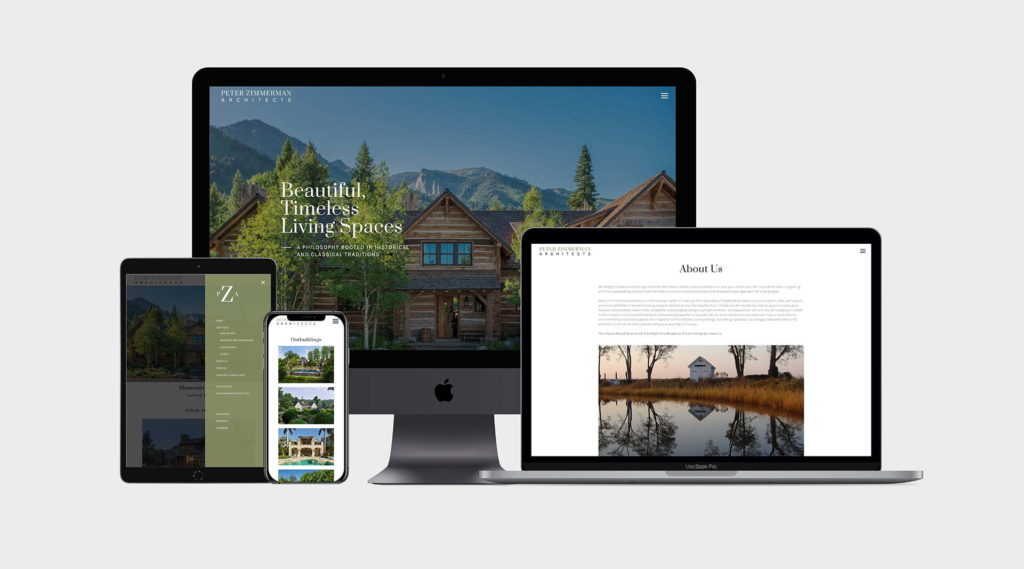
1. Scale:
Start-up websites are great for small to medium-sized businesses who can leverage their website to create real value.
2. Timeline:
Start-up sites have a timeline that is significantly shorter than an Advanced Plan custom site.
3. Budget:
Start-up websites are great for businesses that are ready to make an investment in the asset, but don’t want to break the bank. These sites cut costs and time during development by using a page builder called Divi.
4. Search Engine Optimization (SEO):
Start-up websites don’t rank as well as Advanced Plan custom-built websites. This is due to the page builder, which is heavy enough to slow down a website. If your business needs to compete with strong competition on Google, Start-up websites may not be a good fit.
5. Adaptability / Capability:
You have more power to optimize the performance of your website with a Start-up build. If your website must have a very unique user interface or special capabilities, a custom approach is a better option.
6. Maintenance:
Though it carries less risk than an Advanced Plan, Start-up plan websites rely on some 3rd party code. Sometimes plugin updates will no longer be compatible, and this can cause the site to break.
7. ROI (Return on Investment):
Start-up websites can grow in size with your business, but new functionality may be a challenge. If you’re looking for a website that is very flexible, and can pivot with an agile business, you might want to consider an Advanced Plan build.
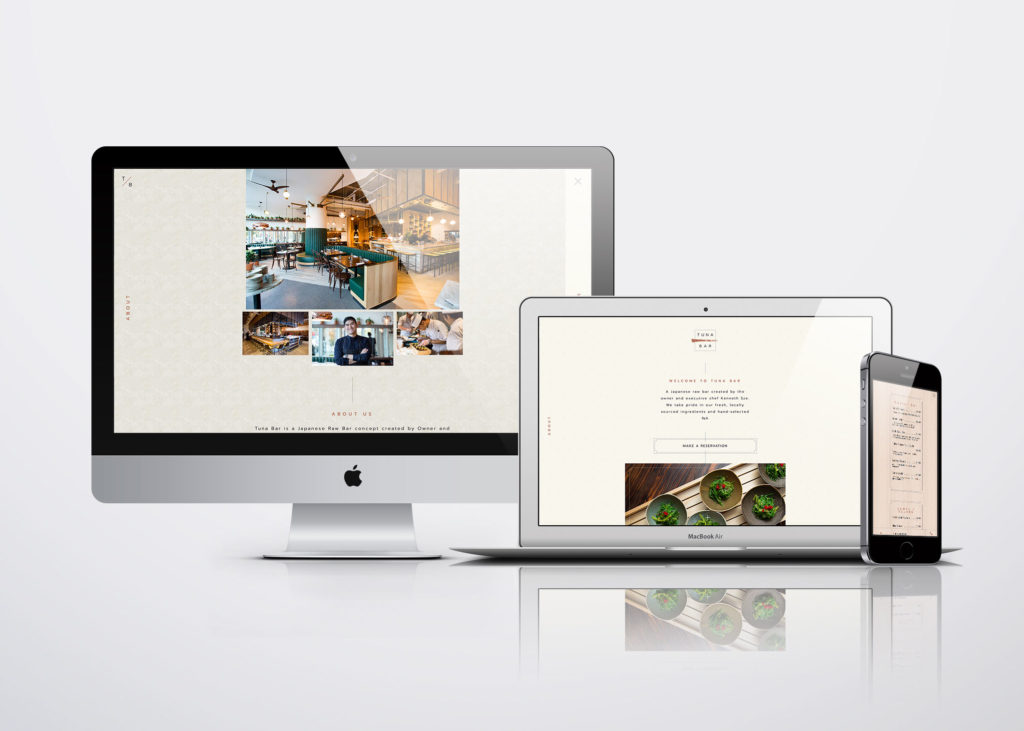
1. Scale:
Advanced Plan websites are typically recommended for medium to large-sized companies who have specific integration needs, leverage complex technology, or must compete in a competitive SEO market.
2. Timeline:
Advanced Plan sites have the longest timeline. They require web design companies to create a custom design and develop the site from the ground up.
3. Budget:
Advanced Plan websites start at a higher price point, but there can be greater opportunities for ROI.
4. Search Engine Optimization (SEO):
Advanced Plan websites can be great for SEO! The code can be optimized to improve rankings.
5. Adaptability / Capability:
The sky’s the limit when it comes to Advanced Plan sites. Essentially any design or technology could be implemented on your custom website. As your business evolves, so can your website!
6. Maintenance:
Advanced Plan sites can be maintained better. This is because it is less reliant on 3rd party code. Advanced Plan websites can be built with code, therefore extending the lifespan of your asset. Their value does not depreciate as quickly as other types of websites.
7. ROI (Return on Investment):
If you have a plan to leverage the capabilities of the site, you won’t regret going with an Advanced Plan website. It will withstand the test of time and can outperform other types of sites.
When it comes to your business’s website, choosing a website doesn’t need to be a difficult decision. Whether you need to enhance brand awareness or create a digital marketing tool, it’s important to understand your business’s goals. Prior to reaching out to web design companies, consider the timeline, budget, audience, and required functionality. Selecting a website that meets your business needs will bring you a step closer to building your ideal tool.
Inclusive design is just what it sounds like. Also known as universal or human-centered design, it means solutions that embrace diversity and are available to all. Multiple Diversity and Inclusion Reports show that companies are still not as inclusive as they should be.
Inclusivity should be a key part of your design thinking process and UX strategy. Not only is it the right thing to do, but it will also help your business and enhance your brand. Not sure where to begin? Follow these steps to start the process and connect to more accessibility resources.
Consider your entire audience. Accessible design means taking an empathetic approach and thinking about experiences outside your own. Understand the issues other users face, then address how to design for these. Identifying your personal bias is key to inclusive design. Creating solutions based on just one perspective will lead to blind spots.

Educate yourself on the difficulties users face. Access impairments include visual, motor, hearing, and cognitive issues. For example, users may have visual impairments that inhibit sight and reading, motor impairments that prohibit using a mouse, or hearing impairments that prevent audio engagement. Additionally, cognitive conditions like dyslexia and autism cause people to engage differently.
Ensure accessibility by involving a diverse user community in research and testing. Beware common UX myths that claim accessibility is too difficult — It is not! Follow an accessibility specific testing process with a clear methodology and focused plan, then take the feedback you receive to inform your next steps.

So how do you go about implementing accessibility? The comprehensive Web Content Accessibility Guidelines from W3C focus on four principles of perceivable, operable, understandable, and robust. The checklist below offers an overview of suggestions and see W3C’s Web Content Accessibility Guidelines for more detailed specifics.
Accessibility Checklist
Designing for different populations means getting creative. Consider how to satisfy ADA Requirements while also creating a great experience for your audience.
Ensure your content is readable through clear fonts and high contrast for readers with visual impairments. Don’t rely too heavily on color; this way your design will be readable to users with colorblindness and a narrower visual perception. You can check color and contrast ratios with online tools created to match WCAG guidelines.
For non-text content, ensure that you have descriptions, labels, captions, and transcripts for users who are not able to see the visual content. Consider if animations, videos and other effects are a roadblock to certain viewers.
Make sure that all functionality is available with the keyboard. Someone unable to use a mouse or touch screen should be able to access all areas of the site.
Make sure that information is clearly organized and eliminate confusion wherever possible. The structure should be easy to understand and intuitive to navigate. Users with low literacy should be able to engage easily.
Your content should be compatible with different browsers and assistive technologies. A variety of user types should be able to interpret your site’s information.

Inclusive Design should be a key part of your brand strategy. Accessibility may seem complex, but it doesn’t have to be. Especially with all the resources available on accessibility. The internet is filled with media lists of books, articles, and more ways to dive deeper into inclusive design. As designers, it is our duty to make sure our products do not exclude anyone. We can all do our part in helping to create a more accessible world.
Optimize your website content for online business. Lately, this has become more important than ever. During the COVID-19 pandemic, digital traffic has soared as physical touchpoints diminished. This is the right time to check that your website is still meeting the needs of your customers.

A call-to-action (CTA) tells your audience to do something. Often, it’s a button on your website. A successful CTA is clear and useful to your customers. During this uncertain time, it’s important to be sure your CTA’s are still relevant to attract online sales.
E-Commerce can be a powerful tool to optimize your website for online business. While physical locations are closed, it’s important to give your customers options. Allow your customers to shop online. Online sales have increased 52% compared with the same time frame a year ago. The number of online shoppers has also increased 8.8% since the coronavirus began, according to Quantum Metric.
Fear not if sales are down because customers crave the experience of your physical location. Gift cards can give your business an immediate boost. It also helps you stay at the top of customers minds.
Memberships and subscription programs are a great marketing tool. Increase customer loyalty by offering bulk deals or incentives. This can transform a one-time purchase into a long-lasting relationship.
Allow customers to immediately connect with you via a chat function. Customers can become confused when many businesses are altering their service. Chat functions drive online business by satisfying customer needs. It may give you an idea about what customers wish you were doing, as well.
Take a fresh look at the copy on your website. Make sure it is still relevant during this time of global crisis. Control the narrative, rather than react, whenever possible. Silence is the worst option. Written content is an important component of optimizing your website for online business.
Be sensitive. Even well-known companies needed to adapt. This is no time for jokes! You don’t want your business to appear tone-deaf. Focus on brand awareness. It’s a not a good time for a sales pitch. Promote strategies at the top of your marketing funnel.
It is a very confusing time. Make sure your customers are getting useful information. Let people know if your business has changed it’s procedures or is operating normally.
Create cheerful and uplifting content. People are looking for a break from the news cycle. Use content to improve your customer experience. This is part of using an effective tone.

Search engine optimization (SEO) is critical to optimizing your website for online business. Your SEO ranking determines how easily users find your website on search engines.
Content is king. Blog posts are a great way to improve your SEO rankings. Write about what your customers want to know. Target your posts by learning about the search habits of your audience.
WordPress is the most popular content management system (CMS). If your website is one of the many using this CMS, Yoast is your new best friend. This WordPress plugin provides guidance to help you achieve better SEO.
A focus keyphrase is the phrase that you want your webpage to return for in a search engines. Choose the right keyphrase. It can have a big impact on who receives your content. Use online tools like Google Trends to understand which keyphrases to use.
Check your website to see if it is meeting the needs of your customers. It can be your most important digital marketing tool. We know this can be tricky, but there will never be a better time to start. Neff’s team is available to help you evaluate your website’s performance and assist with web design and development needs.
As businesses strive for innovative solutions in an evolving marketplace, it becomes increasingly important to provide the best customer experience (CX). It’s about how the audience experiences your brand. This is often different from internal assumptions. Effective CX takes place at every step of the way. This process will provide design validation for customer experiences.
User experience (UX) design is commonly misunderstood. Some people believe it is only involved in websites and apps. Others think it means wireframes. Wireframes are simply a tool for UX Designers to show the interactive content structure. Of course, a UX process should be part of any interactive project. However, user experience design is more than this.
Yes, your creative team went to school, and have plenty of prior experience, but every situation is unique. There are plenty of traditional marketing techniques, which we can combine with new ideas. The trick to finding the right approach often lies in testing the user experience. This is done with consumer research. Digital products benefit from user testing. However, these techniques can be just as useful for traditional marketing strategies. We use a human-centered design approach. This frame our thinking to achieve valuable results.
Your campaign or product has to look and feel good. However, it takes more than this to verify a design will be successful. Our design process begins with defining measurable goals for each project. First, we gather research. This informs a strategic project plan. After that, we are able to tailor creative services to the unique details of your project.
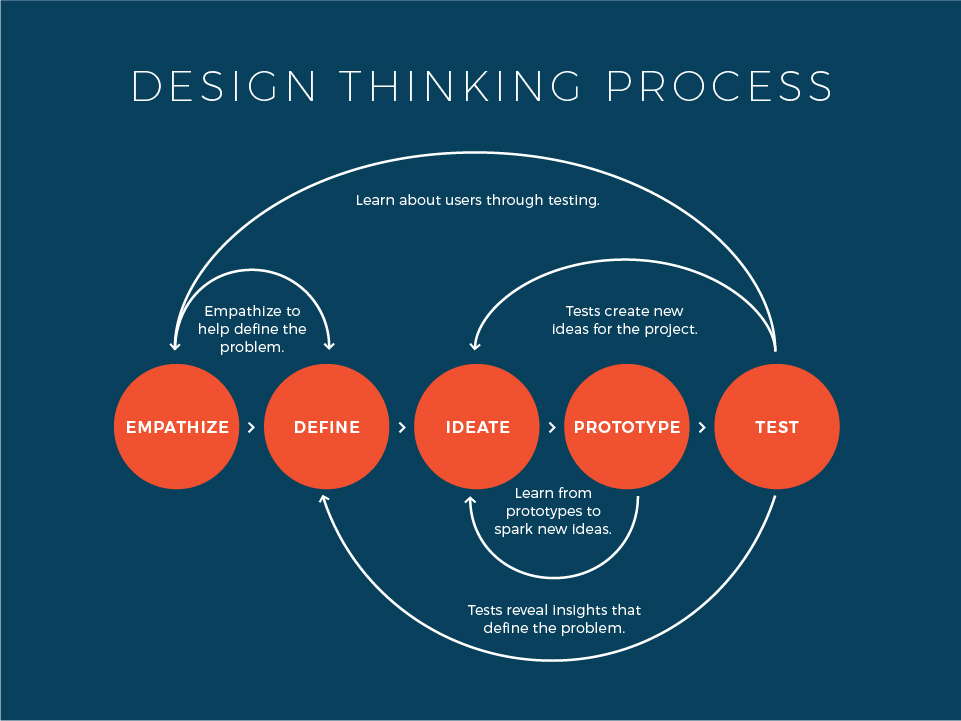
There are a variety research methods for validation. These can be used to measure success at many points. These include moderated and unmoderated user tests. A/B testing can be used to compare two potential solutions. Also, we use surveys and focus groups.
Businesses across many industries can use these approaches for integrated marketing campaigns and experiences. For example, we can compare two billboard designs. An A/B test can compare leads generated from each ad. Websites can also benefit from user tests. These tests could verify that users were able to efficiently locate certain information. Strong designs help business and consumers. Design validation for customer experiences can drive profits and create more useful products.
Making the decision to build a new website, whether it’s a rebuild or a brand new site, is a big decision. The financial and time commitment isn’t light, however, building a new website is a decision that will significantly impact the marketing of your business. A well-designed website can set your business up for substantial growth, while a poorly-designed website with a bad interface and experience could severely decrease your new business leads and negatively impact your customer perception. A well-functioning website is always a crucial part of our integrated marketing campaigns and is the backbone to a successful advertising initiative. You aren’t maximizing your public relations, social media, advertising, and overarching integrated marketing dollars if your website isn’t fully up to web design and experience expectations. It’s important to compare a custom vs templated website design and development and discover what is best for your company.
Your website is a direct reflection of the business you run and services you provide. A user could go to your site and see a high-quality design that was strategically structured and gain a high level of trust with your business or see a hastily thrown-together page and run in the other direction. Most consumers make the subconscious connection, if you don’t care about the perception of your own business, why would you care about your customers? A well-designed, successful website can produce a high ROI for a business and positively reinforce brand perception. With the right user experience, your potential customers have the opportunity to learn about your business, see the quality of the service or product you provide firsthand, and in return, make the decision to contact you for your services. Every new customer is more potential money in your pocket and referrals for additional new business. The design decisions and content on your site is an extension of your advertising and your one chance to win customers over before meeting them face to face.
Now that you’ve decided to move forward with investing in a new website, the next decision is whether to build a custom experience or use a previously designed template. Neither are bad options, and both will produce a high-quality product. The biggest difference between a custom designed and developed website and a templated website are cost and timeline to produce.
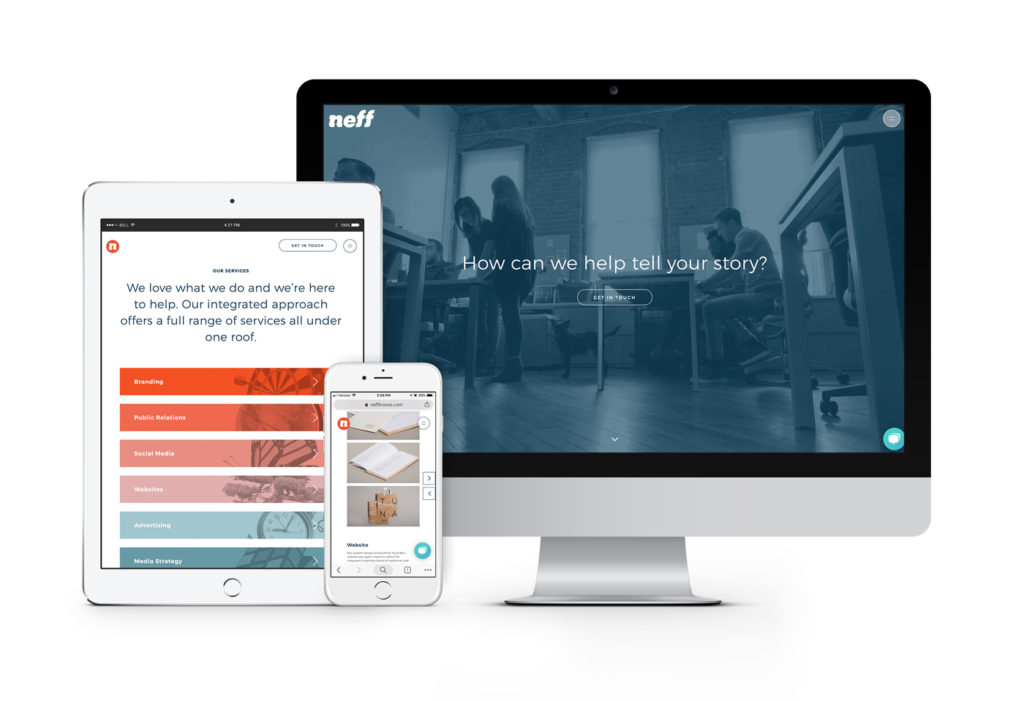
In order to check every item off of your website wish list, whether it’s customized interactions or unique features, you’ll hire an agency to build a completely custom website from the ground up. At Neff, we involve all of our clients in the design process from moodboarding to the mobile version. There is not one item that the client can’t give input on, which allows for complete control throughout the process. Another benefit to having a website custom designed and developed is better SEO results. Custom websites are more searchable and get better rankings because they’re easier for web crawlers (bots that search websites for SEO criteria) to scan.
The downside to having a custom website is that it takes a significantly higher number of hours to complete the design and develop it, which increases both the timeline and the cost of your project. One of the reasons that it increases the timeline (besides having to code an entire website from scratch, of course) is because the developer has to create every element in your CMS (content management system). With a templated approach, the CMS is already pre-determined, and everything is editable. When our developers create content in the CMS, the client has to tell them every aspect they want to be able to edit. Anything they do not specify will not be editable unless a developer changes the code.
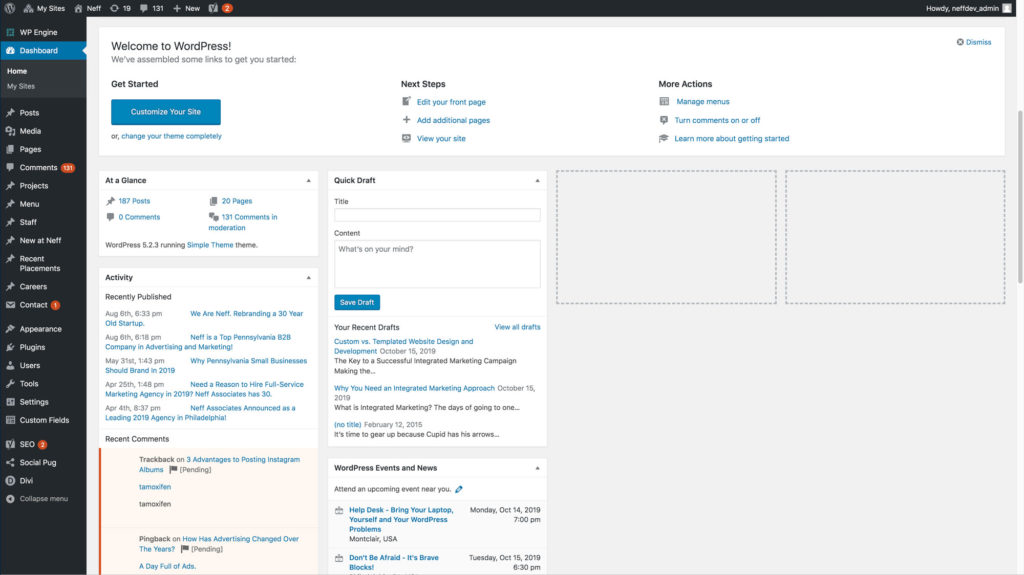
Templated websites are a great option for clients who either do not have a lot of time to build their new website, have a smaller budget to do so, or small businesses who have minimal custom needs. Website templates are beautiful pre-designed websites that have customizable images, content, typography, colors, etc. While the layout of the website is pre-determined, you can still customize it to reflect your branding. There is an abundance of well-designed and developed templates available these days with great interactivity. They take significantly less time to build because the structure is already existing, therefore lowering the cost of the website.
The downside to using a templated website is that you get little to no control over layout, features, or interactivity. You have to fully commit to the template knowing exactly what you can and cannot customize. Once your site is launched, it is very hard, if not impossible, to add any extra features you think of later if they were not included in the purchase of the theme. Another downside to using a template is that template is available to everybody else in the world; your website may look very similar to a lot of other websites.
At the end of the day, there is no right or wrong answer to which path you should take with your website. That decision is based on your budget, your timeline, and your website needs.
At the beginning of every new website design and development project, we ask our clients a series of questions to help determine which route is right for them. Have you allocated a budget? Do you have a specific timeline? What specifically do you need your site to do for you – what is its main function? Can you define the key sections of the site? Which sections/content will you need regular access to for updating? Do you have experience using a CMS? Any special requests/must-haves? Honest answers to these questions will help us determine which type of website will set you up for success.
Neff’s web team specializes in custom website design and development and is well equipped to take your vision from the ground up, but we can also customize a website template for you for a fraction of the cost. Our photography and videography capabilities ensure that our clients have high quality content to show. So what will it be for you? Custom vs templated website design and development is a big decision to make.
No matter which route you decide to go, you will end up with a beautiful website that reflects the quality of your company and gives the user the highest level of trust in your business. Hiring a marketing agency like Neff gives you a full range of options that will cater best to your business and your overarching advertising plan. Take a look at some of the websites we have designed and developed. Once your new website is live, it’s time to drive traffic there and start bringing in the potential new business. An integrated advertising campaign, which usually consists of public relations, social media, media buying, and advertising, will help balance your marketing strategy and drive qualified traffic to your newly designed and developed website.
In 2017 we celebrated our 30th anniversary, and after three decades of marketing excellence in Philadelphia, it was time to update our brand and redefine our mission. We moved on from a brand presence that felt like it was created 30 years go (because, well, it was) to something that reflects our growth and who we are today. So our team and owner, David Neff, took a closer look at our brand, where it came from, and where we want it to go. Have a look at the Neff rebrand process below.
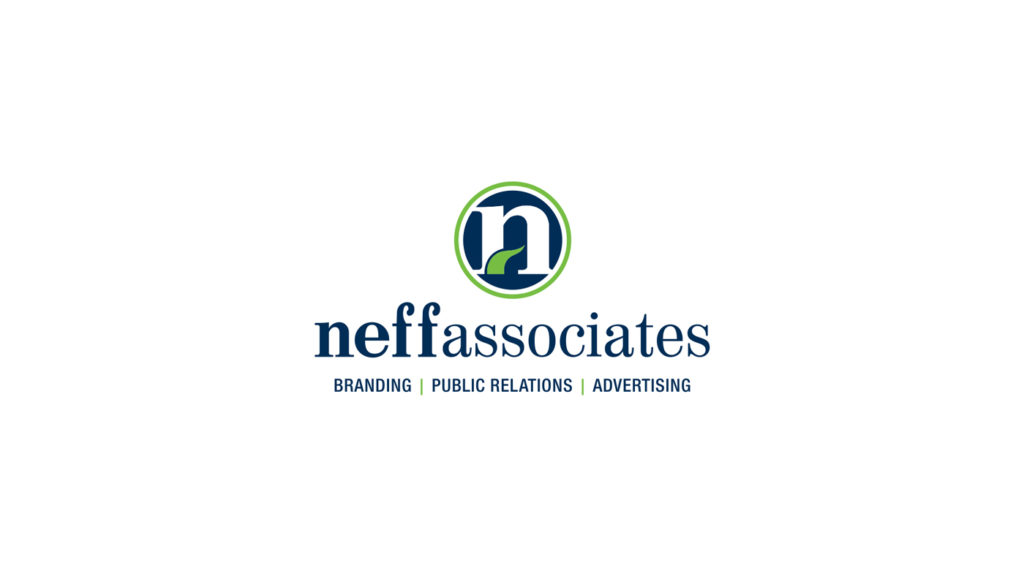
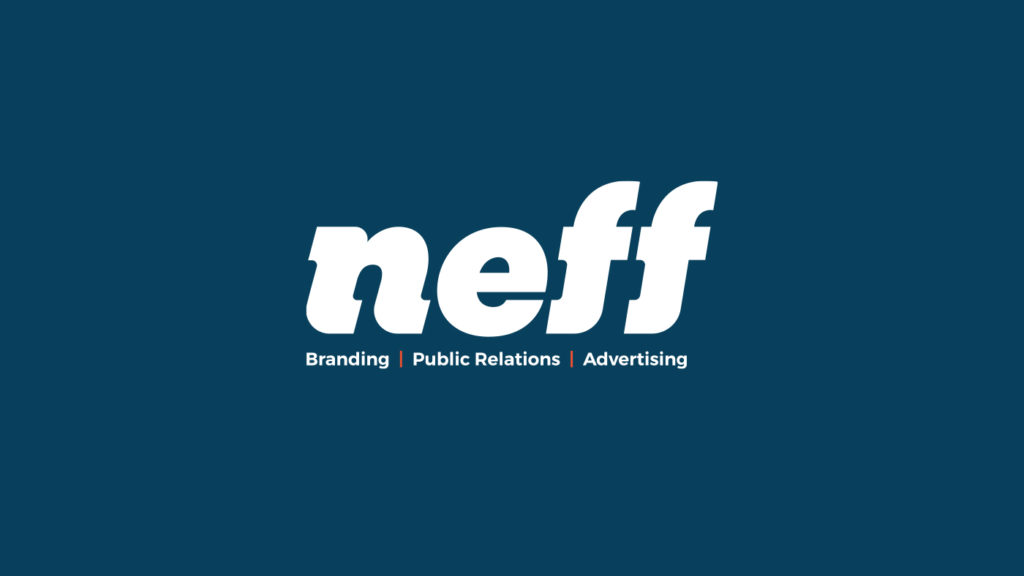
In marketing and advertising, your brand name is synonymous with who you are, what you do and what you stand for. With that, the first thing we wanted to redefine was our mission and our name. We agreed that Neff Associates sounded too buttoned up and old fashioned, more like a law firm than a modern agency, and it didn’t represent who we are. After endless rounds of brainstorming, SWOT analyzing, and a little bit of debate, we concluded that there’s no word that can encompass everything we do. We’re a collaborative full-service agency, meaning we cover all of our clients’ marketing and advertising needs from branding and websites, to public relations and social media, to media strategy, to videography and photography, and everything in between. How could we possibly narrow all of that down to one word or phrase?
We wanted to contemporize our image, to simplify and reflect who we are today.
David Neff, President and CEO
So, we thought, what else could describe who we are? How do people know us? In casual conversation, both internally and with clients, we’ve always cut it short to just “Neff.” Maybe that’s all we needed to be, maybe the new name didn’t have to be totally different, but just instituting a simple phrase that we already use. It was an easy decision; we unanimously decided we are now “Neff!” Goodbye to that stuffy suffix.
Re-branding as Neff would present the opportunity to showcase our creative work and unique office culture. During the process, we took a deeper look at who Neff is. And no, we don’t just mean the guy who started the agency, but the business and the culture he has grown so vastly over the last thirty years. The twenty-three faces who show up to the office every day ready to create and collaborate, the dozens of awards that adorn our lobby walls, the portfolio of work that amazes potential partners every day, the long list of happy clients that span almost every possible industry, the office dogs who give endless kisses, and everything in between. This was all deeply considered during the Neff rebrand.
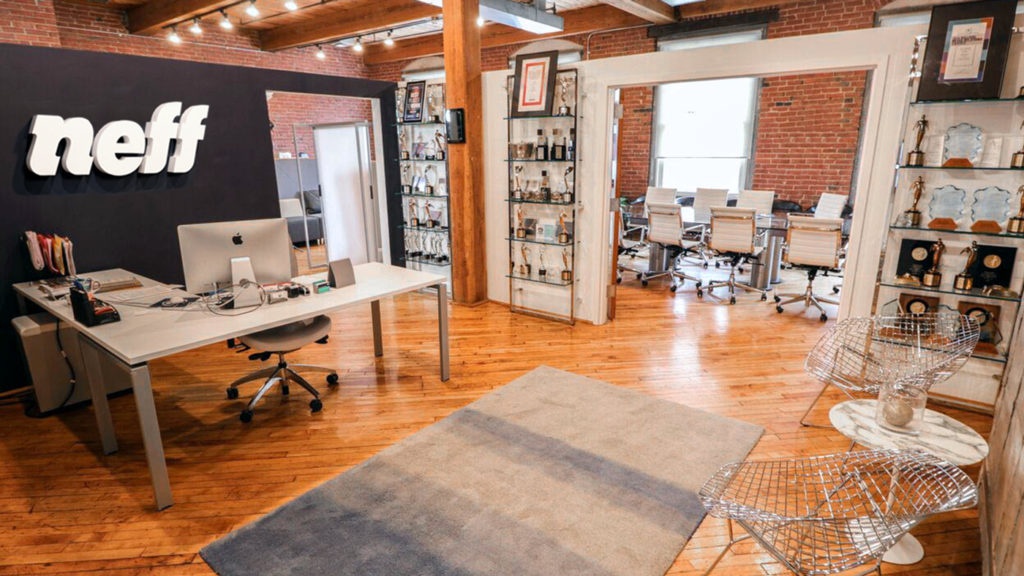
After 30 years, we still have that startup mentality. We hustle and don’t quit, we do whatever it takes to help our clients succeed and builds relationships with those clients. Neff is a full-service marketing agency based in Old City, Philadelphia. Our mission is to use integrated strategies to tell your story and expand your brand. We thrive on collaboration, creativity, and forming strong relations, both internally and with every client.
Great! Now how do we create a logo that encompasses all of that? It was time to put pencil to paper. We first explored dozens of rounds of sketches with the team, breaking one of our biggest rules by involving the whole office every step of the way. But it was important to get every single person’s input, because we all work as a team, and the creative influence of the social and PR teams was just as important as the ideas coming from our designers.
Our first round of sketches consisted of logos from all walks of life: tall, short, wide, thin, square, round. We thought everywhere except inside the box. In the first few rounds of drafts we explored many different logo styles: iconographic, typographic, minimalist, detailed, hand drawn, etc. Seeing all of these different options made the team think even deeper about who we are and how we could show that.
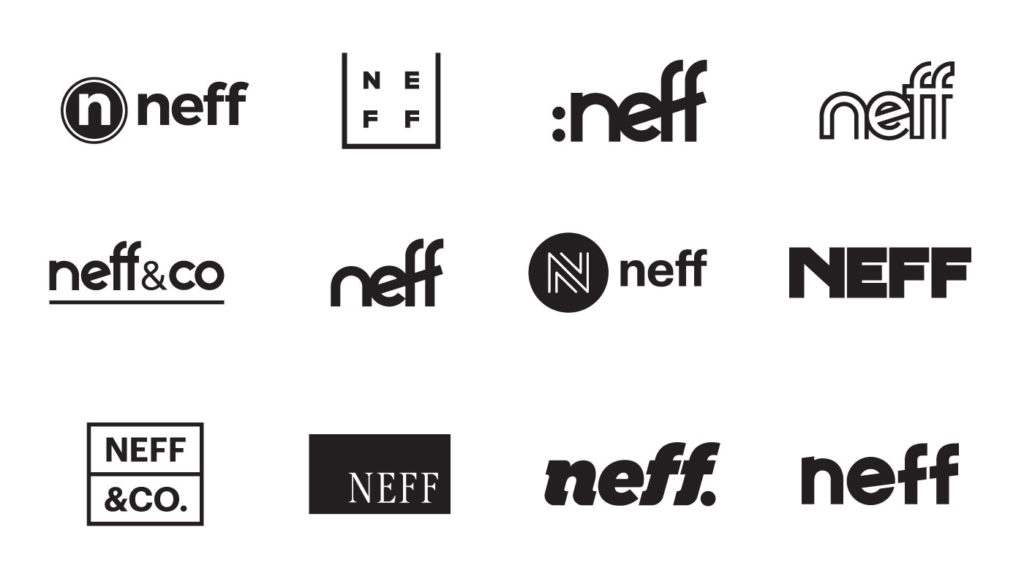
As we narrowed down the logo choices, we paid attention to how we reacted to each design, how each idea correlated with the work that we do for clients and how they connected to our culture. We decided on a direction that was simple, yet bold. This approach would capture the viewers eye, but in an understated way.
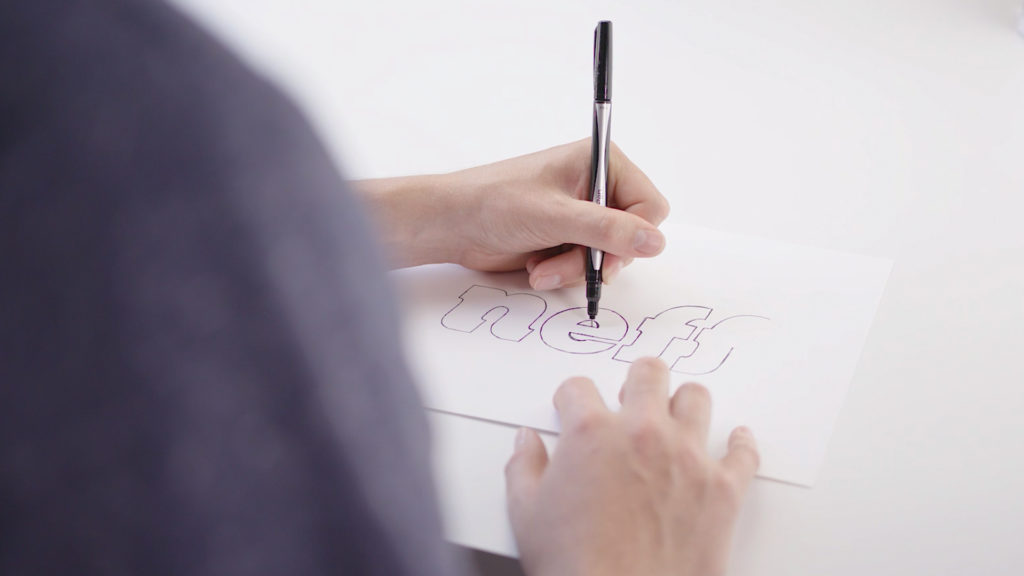
Getting closer and closer to our final mark, we started developing a custom typography solution. What kind of creative agency would we be if we just picked a font and used it? Our designers worked hard to make sure every angle, every curve, was thoroughly thought out.
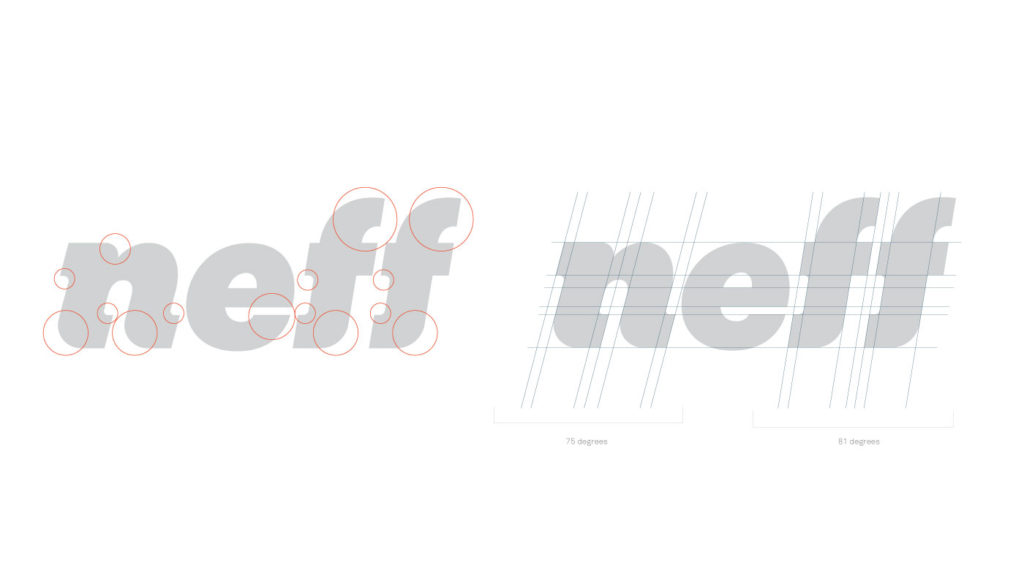
Finalizing the wordmark form wasn’t the end of the journey for this logo. What fun would it be without an icon sidekick? We didn’t want to sacrifice the bold impact of wordmark by putting an icon with it, so we needed one that could stand alone and represent the brand independently as a companion mark. This is where the new logo family in the Neff rebrand started taking shape.
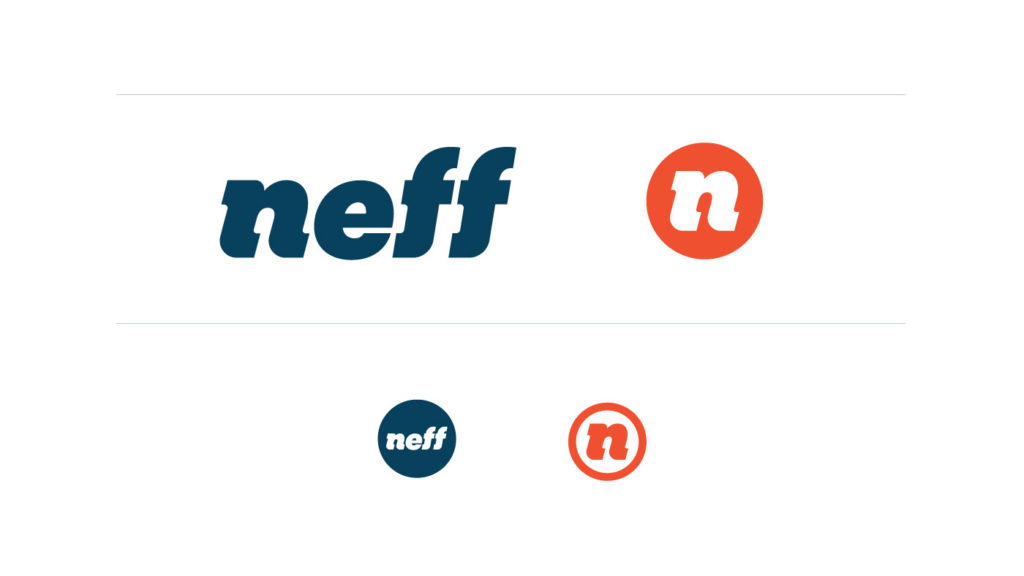
The next agency-wide debate was: go wild with the color or tone it down? As you can see, we compromised. We chose a blend of our classic navy blue and a new bright coral. And for the new color, we wanted to choose something that is loud, yet classy, and has strong character. To emphasize our services coming full circle, we blended the blue and the coral for shades to represent each service.
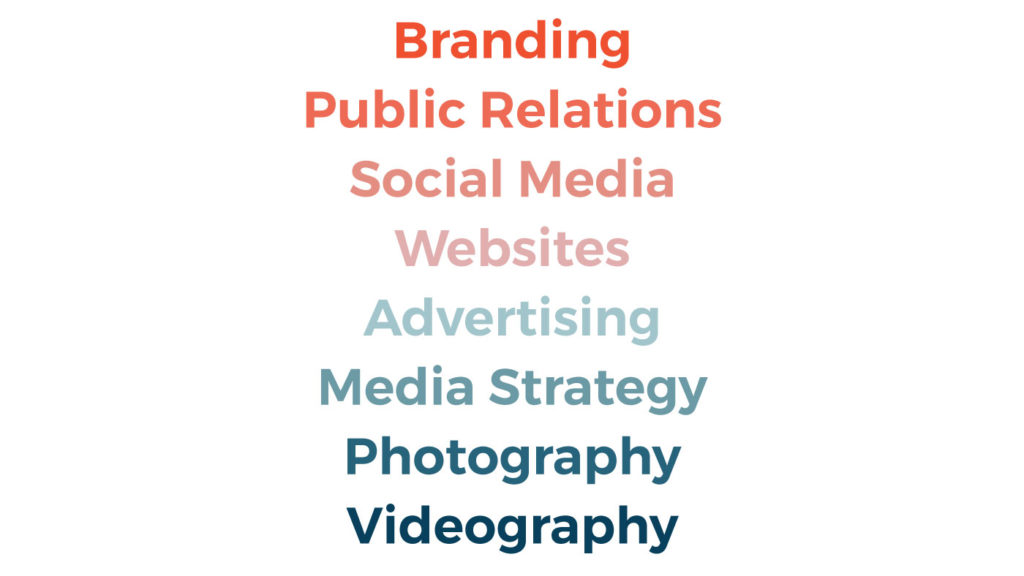
A new brand wouldn’t be complete without rules. Our design team poured countless hours into a 180-page guidelines document communicating how the Neff rebrand should and should not be used. The brand book covers all topics from stretching the logo to blog posts to T-shirt designs. It gives guidance on exactly what we can and can’t do. Our brand coral will never be printed as pumpkin orange, or Santa red, if we have anything to say about it!
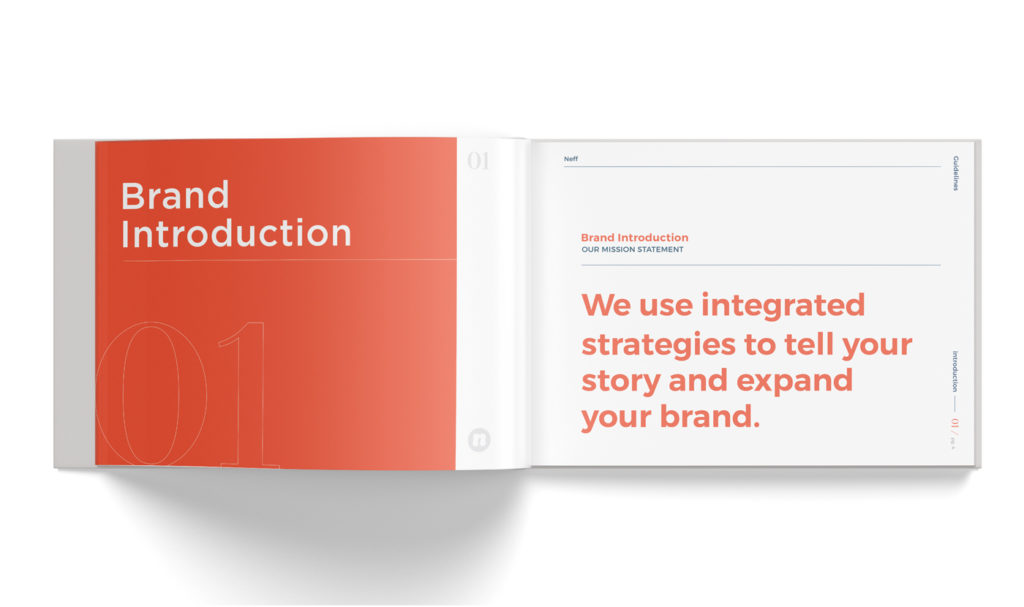
After the rebrand was complete, it was time to bring our new website to life. Content hierarchy was our first priority. Were we thoroughly communicating our capabilities to our audience? Was it immediately obvious how cool we are? It was time to shout to the world what we do it and how effectively we do it. Through an extensive research and architecture phase, we reconstructed the sitemap to create an intuitive experience.
To contrast our new bold brand, we chose a thin, concise font for our page headers and a minimalist type approach to the layout. Our main focus was showing how we help our clients communicate their brand through public relations, social media, branding, websites, advertising, media strategy, videography, and photography. Using eye-catching, yet understated graphics and a bold font to define our services, we let our portfolio do the rest of the heavy lifting.

Now that we had a new brand and a beautiful, updated website to show for it, it was time to let the world know. Through the efforts of our social media team, we launched the new @Neff_Knows campaign. Over the course of a two-day launch, our handles adopted our new tagline and our profiles got a facelift. Not only did we update our social media platforms on the surface, we are undergoing a complete social identity overhaul. With new social guidelines in place, our posts will have an updated, concise style. It reflect our new look and feel.
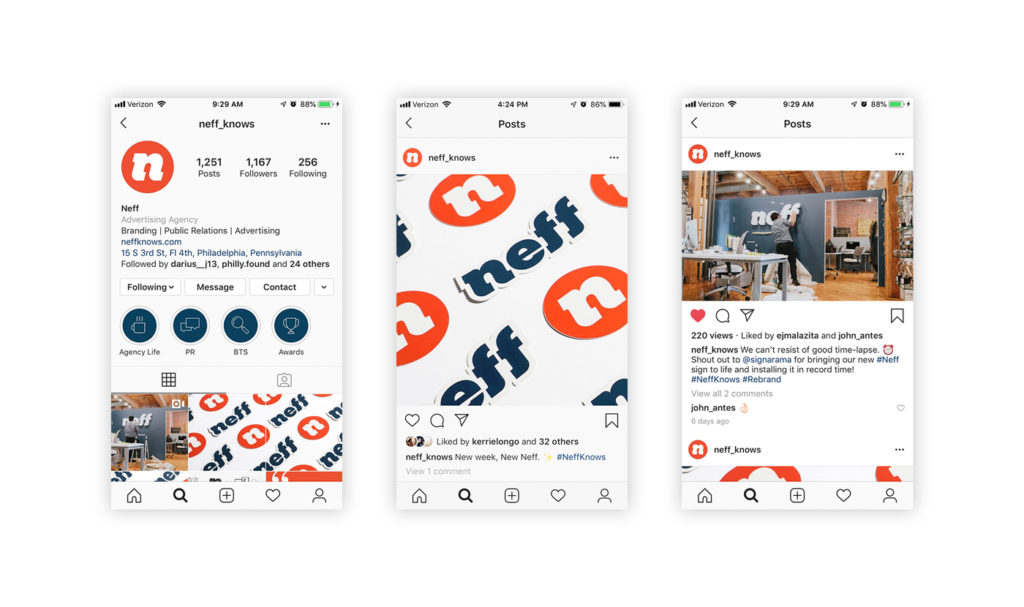
And how could we stop there with the re-branding fun? With no sign of “Associates” in sight, our office is now decked out with new signage and swag. There’s no shortage of newly brand Neff t-shirts, hats, pins, and stickers, and business cards to show off.
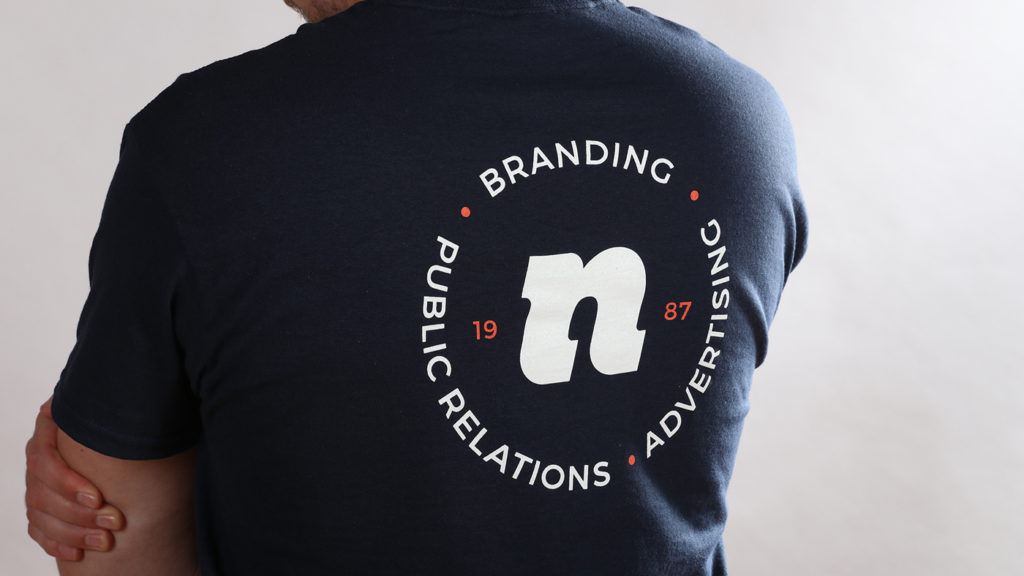
We’re excited to share our new brand with the you. We hope that it gives some insight into the creative, collaborative, innovative agency that we are. Also, we genuinely love helping our clients launch their brands and are thrilled to be able to give ourselves a makeover for the first time in thirty years. (Can we say case of the shoemaker’s child here?) For updates about the Neff rebrand and our clients, follow us on social media @neff_knows and sign up for our newsletter in the footer below.